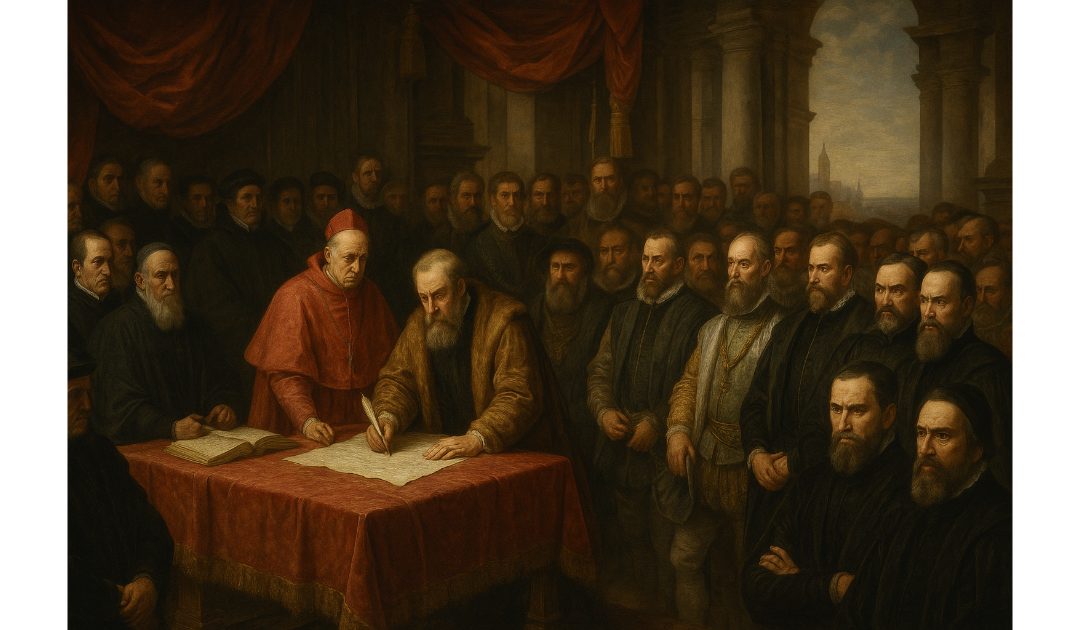The Peace of Augsburg, signed on the 25th of September, 1555, was a pivotal treaty within the Holy Roman Empire that sought to quell the religious tensions that had simmered and erupted since the onset of the Protestant Reformation. This accord, agreed upon by Charles V, Holy Roman Emperor, and the Lutheran princes of the empire, established a significant, albeit temporary, religious settlement that shaped the political and religious landscape of Europe for decades.
Background to the Peace of Augsburg
The Reformation, initiated by Martin Luther in 1517, rapidly spread across the Holy Roman Empire, challenging the Catholic Church’s authority and leading to deep religious divisions. Lutheranism found strong support among various German princes, not only due to theological convictions but also because it offered an opportunity to assert greater independence from imperial control and to appropriate church lands.
As Protestantism proliferated, tensions escalated into violent conflicts, most notably the Schmalkaldic War (1546–1547), where the Catholic forces of Charles V faced the Schmalkaldic League, a defensive alliance of Protestant territories. Charles initially achieved military success, notably at the Battle of Mühlberg in 1547. However, sustaining control over a fragmented and resistant empire proved challenging. The political necessity of compromise became evident as continued warfare threatened the empire’s stability.
Provisions of the Peace of Augsburg
The Peace of Augsburg implemented the principle of cuius regio, eius religio (“whose realm, his religion”), granting the ruler of each imperial state the authority to determine its official religion—either Catholicism or Lutheranism. This principle marked a departure from the idea of religious uniformity under the emperor, acknowledging the empire’s de facto religious pluralism.
Key provisions included:
- Recognition of Lutheranism: Lutheranism was formally recognised as a legitimate faith alongside Roman Catholicism within the empire. This recognition provided legal status and protections for Lutherans, which had previously been absent.
- Religious Autonomy for Princes: Territorial rulers could choose the religion of their realm. Subjects unwilling to conform were permitted to emigrate to regions where their faith was practiced.
- Ecclesiastical Reservation: Catholic bishops or clergy who converted to Lutheranism were required to relinquish their ecclesiastical office and properties. This clause aimed to prevent the erosion of Catholic institutional power.
- Exclusion of Other Protestant Movements: Only Lutheranism and Catholicism received legal recognition. Other emerging Protestant groups, such as Calvinists and Anabaptists, remained outside the treaty’s protections, often facing persecution.
Impact and Significance
The Peace of Augsburg represented a pragmatic solution to the empire’s religious strife. By legitimising Lutheranism and granting rulers religious authority within their territories, it provided a framework for coexistence that reduced immediate conflict. The treaty also underscored the decentralised nature of the Holy Roman Empire, where imperial authority was balanced against the autonomy of its constituent states.
However, the treaty’s limitations were evident. By excluding non-Lutheran Protestants, it sowed the seeds for future conflicts. The rise of Calvinism, in particular, challenged the treaty’s framework, as Calvinist rulers and communities sought recognition and freedom of worship. The ecclesiastical reservation clause also created tensions, especially when Catholic officials converted to Protestantism but resisted relinquishing their positions.
Long-Term Consequences
While the Peace of Augsburg brought temporary stability, it failed to establish a lasting resolution to Europe’s religious divisions. The exclusion of Calvinists and other groups led to renewed religious conflicts in subsequent decades. The treaty’s principle of cuius regio, eius religio entrenched the idea that religious uniformity within a state was desirable, a notion that continued to provoke conflicts when subjects or rulers resisted enforced conformity.
The eventual breakdown of the Peace of Augsburg contributed to the outbreak of the Thirty Years’ War in 1618, a devastating conflict that engulfed much of Europe. The war’s resolution, through the Peace of Westphalia in 1648, built upon and extended the principles established at Augsburg, granting legal recognition to Calvinism and further entrenching the notion of state sovereignty over religious affairs.
Conclusion
The Peace of Augsburg was a landmark in European history, reflecting the complexities of balancing religious diversity with political stability. Although it did not provide a permanent solution, its framework for religious coexistence and the autonomy it granted to rulers influenced the development of state sovereignty and the modern concept of religious tolerance. Its legacy is a testament to the challenges and compromises inherent in managing religious plurality within a political entity.

